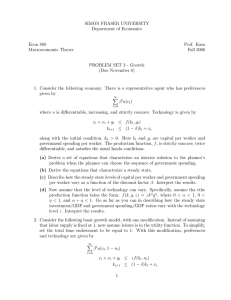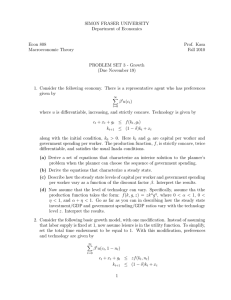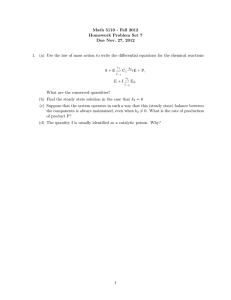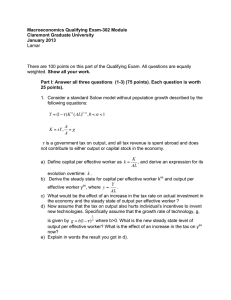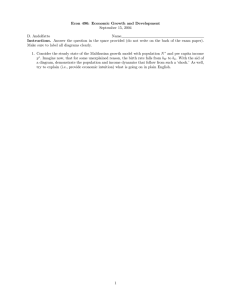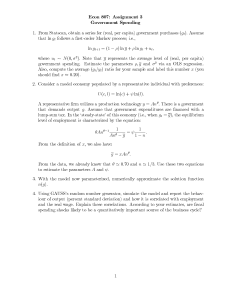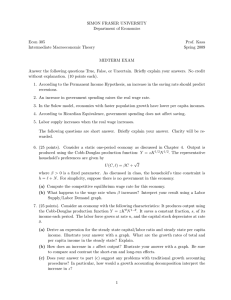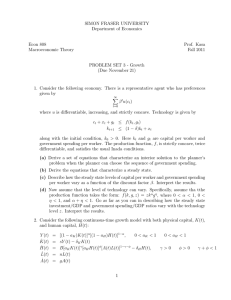SIMON FRASER UNIVERSITY Department of Economics Econ 808 Prof. Kasa
advertisement
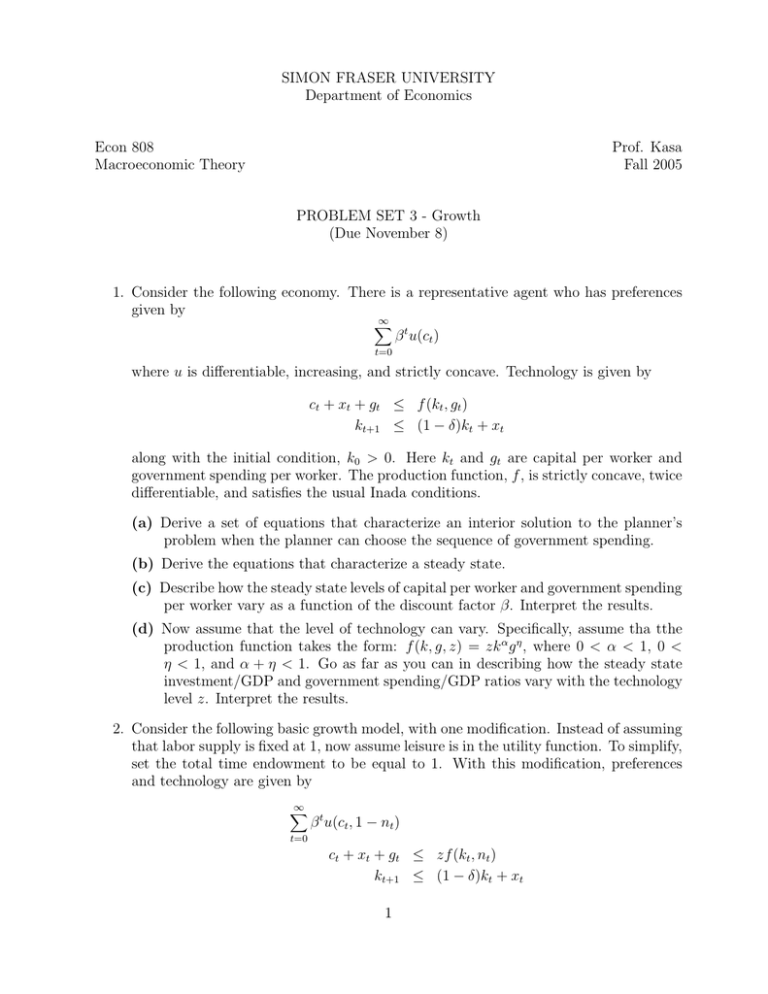
SIMON FRASER UNIVERSITY Department of Economics Econ 808 Macroeconomic Theory Prof. Kasa Fall 2005 PROBLEM SET 3 - Growth (Due November 8) 1. Consider the following economy. There is a representative agent who has preferences given by ∞ t=0 β t u(ct ) where u is differentiable, increasing, and strictly concave. Technology is given by ct + xt + gt ≤ f (kt , gt ) kt+1 ≤ (1 − δ)kt + xt along with the initial condition, k0 > 0. Here kt and gt are capital per worker and government spending per worker. The production function, f , is strictly concave, twice differentiable, and satisfies the usual Inada conditions. (a) Derive a set of equations that characterize an interior solution to the planner’s problem when the planner can choose the sequence of government spending. (b) Derive the equations that characterize a steady state. (c) Describe how the steady state levels of capital per worker and government spending per worker vary as a function of the discount factor β. Interpret the results. (d) Now assume that the level of technology can vary. Specifically, assume tha tthe production function takes the form: f (k, g, z) = zk α g η , where 0 < α < 1, 0 < η < 1, and α + η < 1. Go as far as you can in describing how the steady state investment/GDP and government spending/GDP ratios vary with the technology level z. Interpret the results. 2. Consider the following basic growth model, with one modification. Instead of assuming that labor supply is fixed at 1, now assume leisure is in the utility function. To simplify, set the total time endowment to be equal to 1. With this modification, preferences and technology are given by ∞ t=0 β t u(ct , 1 − nt ) ct + xt + gt ≤ zf (kt , nt ) kt+1 ≤ (1 − δ)kt + xt 1 where nt is the number of hours worked at time t. The remainder, 1−nt , is consumed as leisure. The functions u and f are strictly increasing, concace, and twice differentiable. In addition, f is such that the marginal productivity of captital converges to zero as k → ∞, for all n. (a) Describe the steady state of this economy. Make any additional assumptions required to ensure the existence and uniqueness of the steady state. (b) Now assume that f (k, n) = k α n1−α and u(c, 1 − n) = [cµ (1 − n)1−µ ]1−σ /(1 − σ). What is the effect of changes in technology (i.e., changes in z) on employment and output per capita? Interpret the results. (c) Consider next an increase in g. Are there conditions under which an increase in g results in an increase in the steady state k/n ratio? What about the steady state level of output per capita? Interpret the results. 3. Consider the following continuous-time growth model with both physical capital, K(t), and human capital, H(t): Y (t) K̇(t) Ḣ(t) L̇(t) Ȧ(t) = = = = = [(1 − aK )K(t)]α [(1 − aH )H(t)]1−α , 0 < aK < 1 0 < aH < 1 sY (t) − δK K(t) B[aK K(t)]γ [aH H(t)]φ [A(t)L(t)]1−γ−φ − δH H(t), γ>0 φ>0 nL(t) gA(t) γ+φ<1 where aK and aH are the fractions of the stocks of physical and human capital used in the ‘education sector’, δK and δH are the depreciation rates of physical and human capital, and B is a proportionality constant. Notice that this model assumes that human capital is produced in its own sector with its own production function. Raw labor (L) is useful only as something to be educated, not as an input into the production of final goods. Similarly, knowledge (A) is useful only as something that can be conveyed to students, not as a direct input to goods production. (a) Define k = K/(AL) and h = H/(AL). Derive equations for k̇ and ḣ. (b) Derive an equation describing the set of combinations of h and k such that k̇ = 0. Sketch it in (h, k) space. Do the same for ḣ = 0. (c) Does this economy have a balanced growth path? If so, is it unique? Is it stable? What are the growth rates of per capita output, physical capital, and human capital? (d) Suppose the economy is initially on a balanced growth path, and that there is a permanent increase in s. How does this affect the path of per capita output over time? Explain. 4. Consider the following continuous-time growth model based on Lucas (1988, JME). Suppose that Y (t) = K(t)α [(1 − aH )H(t)]β , Ḣ(t) = BaH H(t), and K̇(t) = sY (t), where Y (t) is output, K(t) is physical capital, H(t) is human capital, and s is the (exogenous) savings rate. Assume 0 < α < 1, 0 < β < 1, and α + β > 1. 2 (a) What is the growth rate of H? (b) Does the economy converge to a balanced growth path? If so, what are the growth rates of K and Y on the balanced growth path? 3
